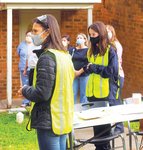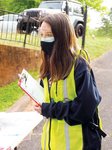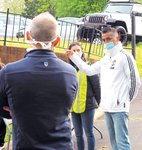



Nearly four months into Chatham’s COVID-19 vaccine rollout, just under a quarter of Chatham’s Hispanic population has been partially vaccinated — a rate over 10 percentage points below the county’s overall average.
“We have made progress over the past four months, but there is still work to do,” Chatham’s Public Health Director, Mike Zelek, told the News + Record Monday.
According to the state vaccinations dashboard, 24.4% of Chatham’s Hispanic population has received at least one dose of the COVID-19 vaccine while 13.2% is fully vaccinated, as of April 19. Comparatively, just over 42% of Chatham’s overall population has been partially vaccinated while 31.2% is fully vaccinated.
Hispanic vaccination rates also trail those of most other ethnic and racial groups in Chatham. Over 38% of both the Asian/Pacific Islander and white populations have been partially vaccinated while 31% of the Black community has received at least one dose. At 10.2% partially vaccinated, only the American Indian community trails Chatham’s Hispanic community in vaccination rates, according to the state’s dashboard.
“When only groups 1 and 2 were eligible, around 3% of vaccinations were among the Hispanic/Latinx population,” Zelek said. “That has more than doubled, but Hispanic/Latinx residents are still underrepresented in COVID vaccinations, as are Black/African American residents, though the disparity is not as large.”
Per the state dashboard, 7.0% of all first doses administered to Chatham residents from mid-December to April 19 have gone to Hispanic residents across all providers. The county’s Hispanic residents account for 12.1% of the overall population.
“It’s not a surprise,” said Will Mendoza, the Hispanic Liaison’s new COVID-19 Project Manager. “The numbers have been, I think, consistent since the vaccination process started. What it confirms for us is the systemic challenge that our community faces — mainly technology driven.”
Vaccination campaigns, he said, depend heavily on internet access and online registration forms — something to which many communities of color have traditionally had limited access. Other obstacles arise, he added, when the vaccination registration processes aren’t intuitive and may not be in someone’s native language.
“The (registration) information doesn’t translate quickly into action,” Mendoza said, “and that is a gap that El Vínculo is trying to fill by constant work with partners, talking to health officials about the challenges that the community is having, so they can update their procedures and improve the accessibility.”
The technological divide and accessibility issues have presented obstacles to vaccination for some Latino residents, but those aren’t the only challenges in play, as many among the community have told the News + Record. Many Hispanic residents simply weren’t eligible to receive the vaccine during the early months of the county’s vaccine rollout, Zelek said.
For the first two months, only frontline medical workers as well as adults 65 years and older had been eligible to get vaccinated. In Chatham, only about 2.4% of all adults 65 and older are Hispanic.
“This affected rates early in the vaccination roll-out (while not discounting these other structural issues),” Zelek said. “Most of the 18 and under population cannot yet get vaccinated (other than 16-17 year olds), and Hispanic/Latinx residents account for about a quarter of Chatham residents under 18.”
Of all three vaccines approved in the U.S. for Emergency Use Authorization, only the Pfizer vaccine may be administered to 16- and 17-year-olds. Most Chatham-based vaccine providers only offer the Moderna vaccine, which can only be administered to adults 18 years and older.
Vaccine hesitancy and misinformation may have depressed vaccination rates among the Hispanic community, too. Father Julio Martinez of St. Julia Catholic Church told the News + Record several weeks ago that he had seen a lot of vaccine mis- and disinformation circulating around the web and among his congregation.
“That has created fear and reservation in many people’s minds,” he said. “I have ... tried to quell that fear by telling our people that we need to listen to the medical experts and not these crazies that are putting out all kinds of misinformation and filling people’s minds with fear. And I continue to do that because we need to do this for the common good.”
The Liaison’s Hannia Benitez, who previously worked as the organization’s interim COVID-19 Project Manager, also told the News + Record that she’d been working to fight similar vaccine myths and fears.
“There’s so much misinformation,” she said in that moment. “We hear like, ‘Well, they said, we’re going to get mutated.’ I had a person that I called earlier (that) week, and she’s like, ‘I heard that people become zombies.’”
The Liaison has been conducting a months-long vaccine education campaign. Together with county health departments and local vaccine providers, staff have hosted several “well-received” Facebook Live events in Spanish to debunk vaccine myths and tell viewers how to get vaccinated in both Chatham and Alamance counties.
That’s why Mendoza said he thinks systemic issues — like the technological divide and lack of access — are driving low Hispanic vaccination rates in Chatham more so than vaccine misinformation or hesitancy. As such, he said the Liaison has been working most recently with vaccine providers to help Hispanic residents sign up for vaccinations and overcome systemic barriers to vaccination access.
“I think that is the direction that we’re trending,” he said, “but from information to execution, you know, it takes a little bit of time.”
In March, staff helped coordinate a vaccination clinic at St. Julia’s, where the health department vaccinated 280 Hispanic residents. This coming Saturday, they’ll be at St. Julia’s again with the health department ensuring that residents receive their second Moderna shots. The clinic will also administer about 100 first doses, Mendoza said.
“We’re promoting it on social media, and we’re trying to get the attention of more people to get vaccinated,” he said. “Based on the response, if we have a large waiting list, we’ll try to have another clinic to serve whatever people don’t get the vaccine this Saturday.”
Likewise, Chatham’s health department has made “intentional efforts” to reach out to Hispanic residents, Zelek said, and will continue doing so. As of Tuesday morning, 14.4% of the health department’s first doses have gone to Latino residents, a rate nearly double the county’s combined average.
As part of its “intentional efforts,” the CCPHD has worked with predominantly Hispanic churches — including St. Julia and Roca Fuerte in Pittsboro — to organize mass vaccination clinics. They’ve sent doses to Mountaire Farms to help the company vaccinate its predominantly Hispanic workforce, and they’ve also gone directly into Spanish-speaking neighborhoods, like Love’s Creek, to sign up residents and even carry out a few vaccinations.
Moving forward, Zelek said the CCPHD will continue working with community partners to share information and increase vaccination access. But ultimately, he added, it’ll take more than a single provider to close the Hispanic vaccination gap in Chatham.
“As a provider, we have shown that these intentional efforts can help to overcome these structural issues,” Zelek said. “Collectively, we have work left to do to narrow this gap.”
Reporter Victoria Johnson can be reached at victoria@chathamnr.com.